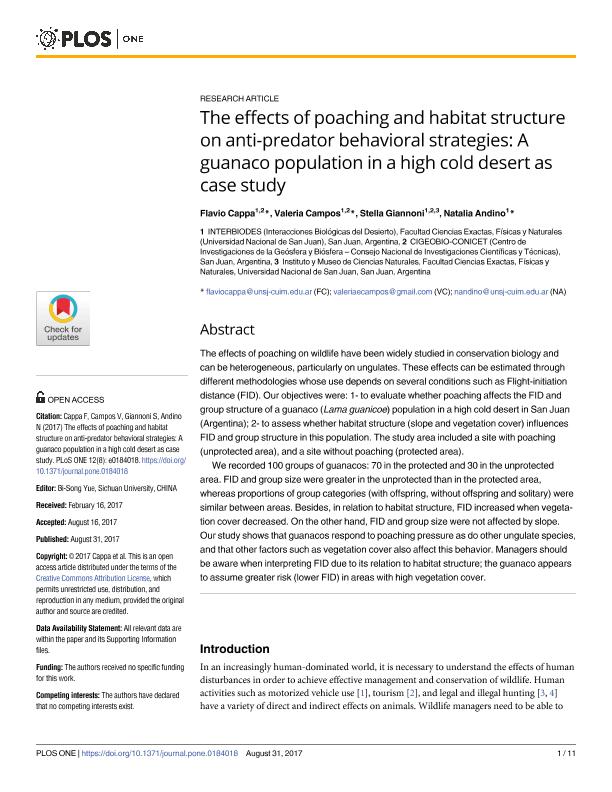Artículo
The effects of poaching and habitat structure on anti-predator behavioral strategies: a guanaco population in a high cold desert as case study
Fecha de publicación:
09/2017
Editorial:
Public Library of Science
Revista:
Plos One
ISSN:
1932-6203
Idioma:
Inglés
Tipo de recurso:
Artículo publicado
Clasificación temática:
Resumen
The effects of poaching on wildlife have been widely studied in conservation biology and can be heterogeneous, particularly on ungulates. These effects can be estimated through different methodologies whose use depends on several conditions such as Flight-initiation distance (FID). Our objectives were: 1- to evaluate whether poaching affects the FID and group structure of a guanaco (Lama guanicoe) population in a high cold desert in San Juan (Argentina); 2- to assess whether habitat structure (slope and vegetation cover) influences FID and group structure in this population. The study area included a site with poaching (unprotected area), and a site without poaching (protected area). We recorded 100 groups of guanacos: 70 in the protected and 30 in the unprotected area. FID and group size were greater in the unprotected than in the protected area, whereas proportions of group categories (with offspring, without offspring and solitary) were similar between areas. Besides, in relation to habitat structure, FID increased when vegetation cover decreased. On the other hand, FID and group size were not affected by slope. Our study shows that guanacos respond to poaching pressure as do other ungulate species, and that other factors such as vegetation cover also affect this behavior. Managers should be aware when interpreting FID due to its relation to habitat structure; the guanaco appears to assume greater risk (lower FID) in areas with high vegetation cover.
Palabras clave:
Flight Behavior
,
Group Size
,
Human Activities
,
Lama Guanicoe
Archivos asociados
Licencia
Identificadores
Colecciones
Articulos(CIGEOBIO)
Articulos de CENTRO DE INVESTIGACIONES DE LA GEOSFERA Y BIOSFERA
Articulos de CENTRO DE INVESTIGACIONES DE LA GEOSFERA Y BIOSFERA
Citación
Cappa, Flavio Martín; Campos, Valeria Evelin; Giannoni, Stella Maris; Andino, Natalia del Pilar; The effects of poaching and habitat structure on anti-predator behavioral strategies: a guanaco population in a high cold desert as case study; Public Library of Science; Plos One; 12; 8; 9-2017; 1-11; e0184018
Compartir
Altmétricas




